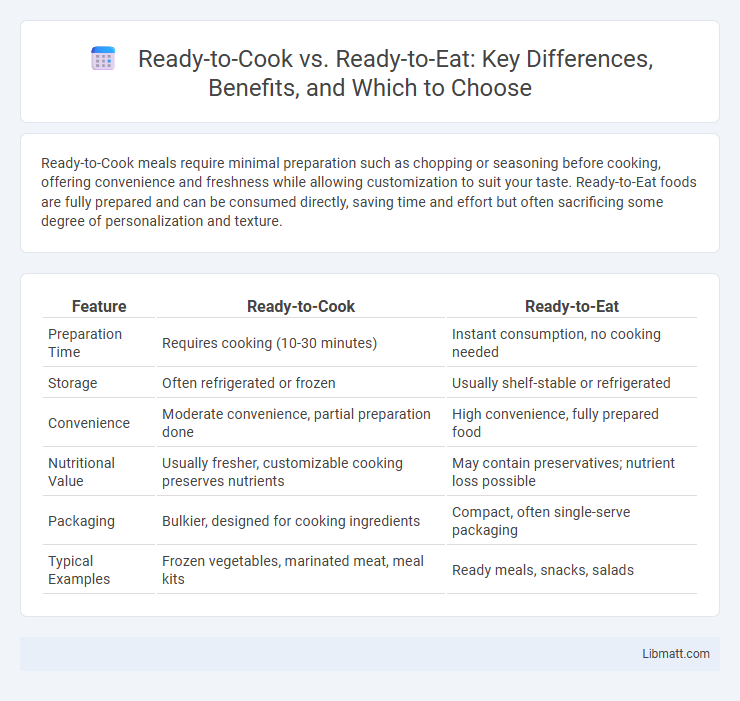Ready-to-Cook meals require minimal preparation such as chopping or seasoning before cooking, offering convenience and freshness while allowing customization to suit your taste. Ready-to-Eat foods are fully prepared and can be consumed directly, saving time and effort but often sacrificing some degree of personalization and texture.
Table of Comparison
| Feature | Ready-to-Cook | Ready-to-Eat |
|---|---|---|
| Preparation Time | Requires cooking (10-30 minutes) | Instant consumption, no cooking needed |
| Storage | Often refrigerated or frozen | Usually shelf-stable or refrigerated |
| Convenience | Moderate convenience, partial preparation done | High convenience, fully prepared food |
| Nutritional Value | Usually fresher, customizable cooking preserves nutrients | May contain preservatives; nutrient loss possible |
| Packaging | Bulkier, designed for cooking ingredients | Compact, often single-serve packaging |
| Typical Examples | Frozen vegetables, marinated meat, meal kits | Ready meals, snacks, salads |
Introduction to Ready-to-Cook and Ready-to-Eat Foods
Ready-to-Cook foods are minimally processed products that require cooking before consumption, offering convenience while maintaining freshness and nutritional value. Ready-to-Eat foods come pre-cooked or processed, allowing immediate consumption without further preparation, ideal for quick meals and on-the-go lifestyles. Both categories cater to different consumer needs, balancing convenience, taste, and health considerations in the modern food market.
Key Differences Between Ready-to-Cook and Ready-to-Eat
Ready-to-cook foods require preparation such as heating or combining ingredients before consumption, while ready-to-eat options are pre-cooked or processed for immediate consumption without further cooking. Key differences include storage requirements, with ready-to-cook items often needing refrigeration or freezing to preserve freshness, whereas ready-to-eat foods are designed for convenience and quick access. Your choice depends on convenience needs, cooking skills, and time availability, impacting meal planning and nutritional control.
Convenience: Which Option Saves More Time?
Ready-to-eat meals save you more time by eliminating preparation and cooking steps, allowing immediate consumption. Ready-to-cook products require additional time for chopping, seasoning, and cooking, providing flexibility but less convenience. For busy lifestyles, ready-to-eat options maximize time efficiency and ease of use.
Nutritional Value Comparison
Ready-to-cook meals often retain higher nutritional value compared to ready-to-eat options because they undergo minimal processing and heat exposure, preserving essential vitamins and minerals. Ready-to-eat meals typically contain added preservatives, sodium, and fats to enhance shelf life and flavor, which can reduce their overall nutritional quality. Choosing ready-to-cook products allows better control over cooking methods, helping maintain nutrient density and promote healthier eating habits.
Food Safety and Shelf Life Considerations
Ready-to-Cook foods require proper handling and thorough cooking to eliminate harmful bacteria, ensuring food safety, while Ready-to-Eat products are processed to be consumed directly with minimal risk of contamination. Shelf life for Ready-to-Cook items is generally longer due to raw or minimally processed ingredients but demands strict refrigerated or frozen storage. Your choice should account for ease of preparation versus the necessity for vigilant storage and cooking practices to maintain safety and freshness.
Cost Analysis: Budgeting for Ready Meals
Ready-to-cook meals generally offer lower upfront costs compared to ready-to-eat options, making them more budget-friendly for those who want fresh, homemade flavors without extra preparation time. Ready-to-eat meals often include higher convenience fees, reflecting their processing, packaging, and longer shelf-life, which can impact your overall food budget. Evaluating your budget for ready meals requires balancing cost savings with the value of convenience and freshness.
Taste and Quality: Freshness Matters
Ready-to-cook meals often deliver superior taste and quality because you control the cooking process, ensuring optimal freshness and customized flavor. Ready-to-eat products prioritize convenience but may compromise on freshness, resulting in less vibrant flavors and texture. Your choice influences the sensory experience, with ready-to-cook options typically preserving the natural taste and quality of ingredients.
Environmental Impact: Packaging and Waste
Ready-to-Cook meals often generate less packaging waste compared to Ready-to-Eat options, as they typically use simpler, recyclable materials designed to preserve raw ingredients. Ready-to-Eat products usually require multilayered packaging to ensure longer shelf life and immediate consumption, leading to higher environmental impact due to non-recyclable components. Understanding these differences helps you make environmentally responsible food choices by minimizing packaging waste and its ecological footprint.
Choosing the Right Option for Your Lifestyle
Ready-to-cook meals offer flexibility for those who enjoy customizing flavors and controlling cooking times, making them ideal for individuals with some kitchen time. Ready-to-eat options provide convenience and time-saving benefits, perfect for busy schedules or on-the-go lifestyles where minimal preparation is desired. Consider your daily routine and cooking preferences to select the option that best supports your lifestyle needs.
Future Trends in Ready-to-Cook and Ready-to-Eat Markets
Future trends in the ready-to-cook and ready-to-eat markets include increased demand for healthier, organic, and plant-based options driven by consumer focus on nutrition and convenience. The integration of smart packaging technology enhances shelf life and product safety, meeting consumer expectations for freshness and sustainability. Your purchasing decisions will benefit from these innovations as brands prioritize personalization and rapid delivery in response to evolving lifestyle needs.
Ready-to-Cook vs Ready-to-Eat Infographic

 libmatt.com
libmatt.com